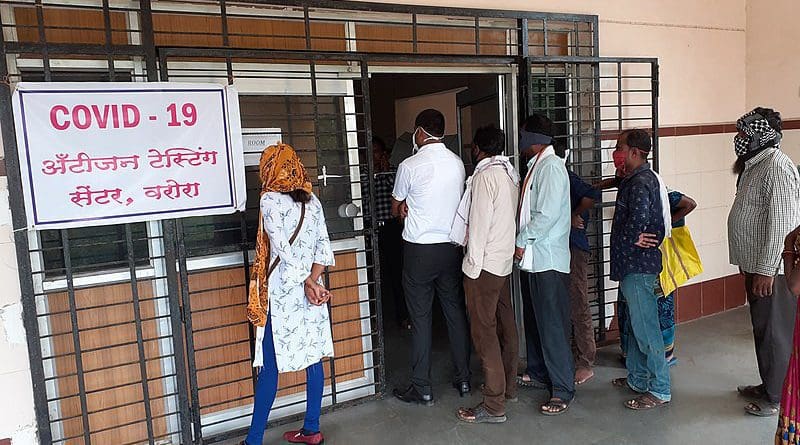Why Is India Rolling Back COVID-19 Food Aid? – Analysis
By Jose Ma Luis Montesclaros*
Since 2013 India has allocated subsidised grains for its poorer populations under the National Food Security Actat a cost of approximately US$24 billion annually. In April 2020, the government allocated additional grain as COVID-19 food aid at an additional cost of approximately US$47 billion, known as the Pradhan Mantri Garib Kalyan Anna Yojana (PMGKAY).
The PMGKAY program was hailed by an IMF report as critical to preventing a significant increase in extreme poverty in India. But in December 2022 the Indian government decided to consolidate and roll back the PMGKAYgiven the nation’s steady economic recovery following the COVID-19 pandemic. The policy reversal owes partly to the high price of wheat, which increased by 33 per cent in 2022 alone.
The recent move reflects a fine balancing act by the government, which is caught between addressing the interests of the ‘poorest of the poor’ and those of marginalised individuals who need to purchase food in the open market. The National Food Security Act caters to 75 per cent of the rural population and 50 per cent of the urban population based on criteria for ‘poorest of the poor’ set out in the separate Antyodaya Anna Yojana food subsidy program. Removing the additional PMGKAY subsidies is expected to increase the amount of wheat that can be released into the market, thereby taming food price inflation.
Higher wheat prices are normally a reflection of domestic shortages in India’s open markets. Amid the pandemic and the war in Ukraine, India’s domestic wheat prices rose as wheat supplies were diverted into international markets. In response, India banned wheat exports in May 2022 to cool domestic wheat price inflation. But after falling briefly immediately after the ban, domestic wheat prices then increased further.
This showed that inflation was no longer being driven by the diversion of domestic wheat to exports. The problem had evolved into one of shortfalls in domestic production. Climate challenges are partly to blame, as farmers have seen hotter temperatures reduce wheat harvest quantity and quality.
A key uncertainty is how much wheat will be harvested in March 2023, as this will determine the level of wheat supplies in the country for the remainder of the year. India’s harvests have traditionally followed a cyclic pattern, with some years experiencing exceptionally good harvests. But the potential for a future shortage resulting from production uncertainties can induce traders to speculate about higher future prices. This can lead to hoarding behaviour among traders and consumers alike as well as self-realising expectations of domestic price inflation.
In this regard, the rollback of the PMGKAY and the release of wheat into the open market can be seen as a cooling mechanism to nip speculation in the bud by diverting wheat away from subsidised distribution and into the open market. In the near-term, this is a tactical pre-emptive move to prevent further contagion of inflation arising from price speculation.
It is yet to be seen whether the cancellation of the PMGKAY will translate into the release of more grain into the open market. But regardless, India’s rollback of the PMGKAY does not address the core issue, which is the wheat export ban itself. It is important to recognise that the wheat export ban has contributed to precipitating the domestic grain shortage.
For India’s farmers, the ability to cater to international demand for wheat at higher prices means larger profits, which incentivises greater investment in wheat production. The wheat export ban prevented farmers from reaping profits from international demand, translating to the hiring of fewer workers and the use of cheaper wheat varieties that require fewer inputs like fertilisers and pesticides. In the long term, India must address the negative effects of the wheat export ban on wheat producers’ incentives.
Looking forward, the Indian government will continue to play an important role in taming price expectations among traders and farmers, as well as incentivising investment in wheat production. One approach would be to provide some assurance that the wheat export ban will be lifted later in 2023. But the impact of such an announcement may be limited as most of the wheat for the March 2023 harvest will have already been planted. Some farmers have already advanced their farming schedules amid fears of hotter temperatures.
But such an announcement might still convince farmers to invest more resources into the latter part of the wheat growing cycle, including using pesticides to protect their wheat from pests and diseases and hiring more labour to support timely harvests and minimise wastage.
Another approach is to ensure that the savings from consolidating India’s food aid policies, which will amount to approximately US$20 billion in 2023, are invested into developing a more resilient food system. Investing in research and development, infrastructure, information systems and training could help in ‘climate-proofing’ and smoothing future production.
*About the author: Jose Ma Luis Montesclaros is Research Fellow with the Centre for Non-Traditional Security Studies at the S. Rajaratnam School of International Studies, Nanyang Technological University, Singapore.
Source: This article was published by East Asia Forum

